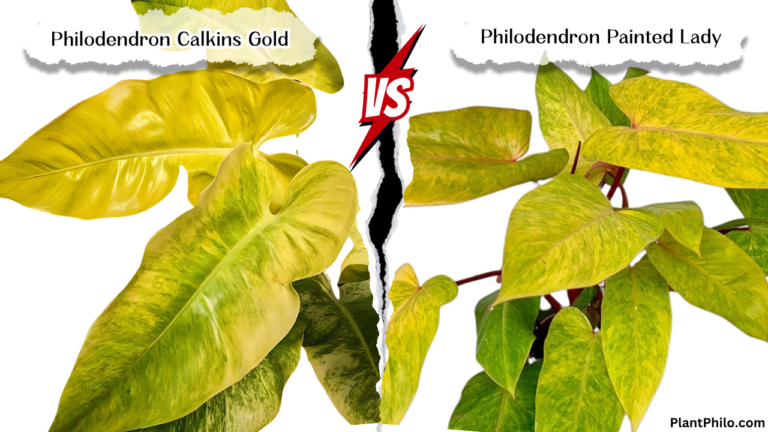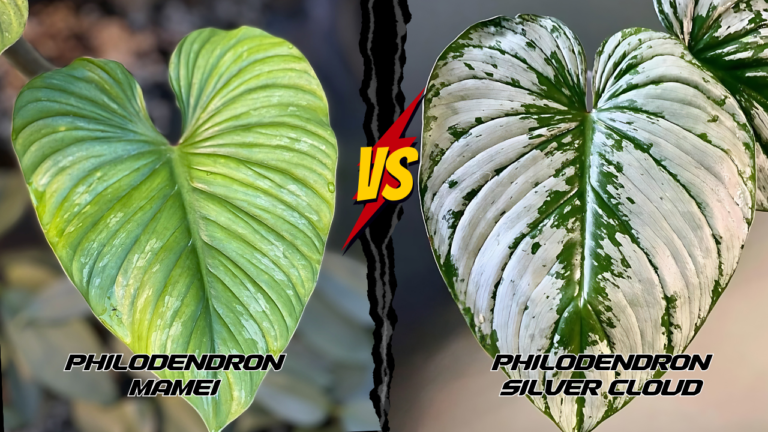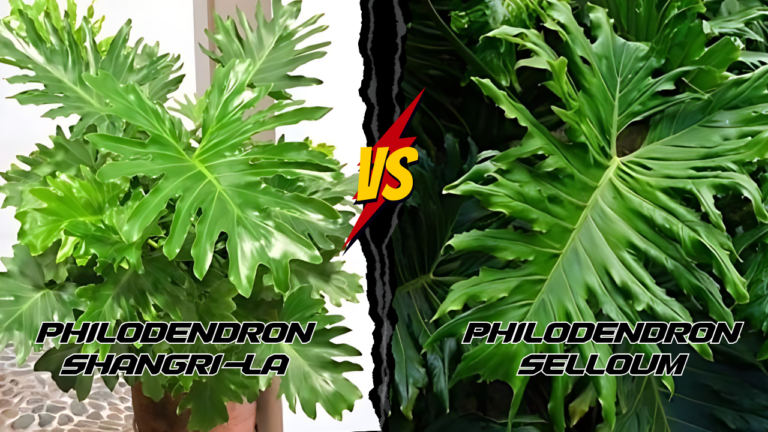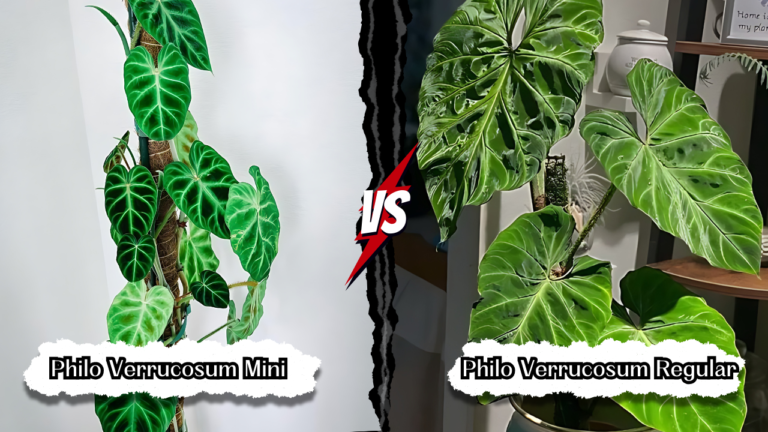Philodendron Plowmanii vs Gloriosum: Ultimate Comparison Guide
Philodendron Plowmanii and Philodendron Gloriosum are two popular Araceae houseplants. Both are known for their impressive foliage and relatively easy care needs.
The main differences between Philodendron Plowmanii and Philodendron Gloriosum include leaf texture, size, and growth habit.
This article gives an overview of plant features, care guide and propagation techniques for both Philodendron Plowmanii and Gloriosum to help you choose the best plant for your home or garden.
Philodendron Plowmanii vs Gloriosum: Quick Comparison Table
| Key features | Philodendron Plowmanii | Philodendron Gloriosum |
| Visual Characteristics | More textured, ruffled appearance and lack of white veins. | glossy, heart-shaped leaves with distinct variegation and white veins. |
| Growth Habit | Creeping | Climbing |
| Size | 8 feet long and 5 feet wide | 12 inches long and 8 inches wide |
| Prefer Sunlight | Filtered sunlight | Filtered and indirect sunlight |
| Regular watering | More Frequent | Less frequent |
| Best for | Vertical spaces | Horizontal space |
Philodendron Plowmanii
Philodendron Plowmanii originates from rainforests in Ecuador and Peru. It has large heart-shaped leaves with wavy patterns on them. The yellowish-green leaves have light pink petioles along with beautiful red roots.
1. Light Requirements
Moderate to bright indirect lighting is ideal for this plant’s growth. To avoid burning the leaves, they should be protected from direct sunlight.
2. Watering
Consistent moisture is preferred by this plant. If you water it before one inch of soil has dried on top you will encourage root rotting. Overwatering can cause yellowing in leaves as well as mushy stems.
3. Soil and Planting
It requires a potting mix that drains well, which often includes 60% potting soil, 30% perlite, and 10% coco coir. This combination helps regulate humidity levels while still allowing excess water to drain away easily.
4. Temperature and Humidity
On average the temperature range for Philodendron Plowmanii is 55°F to 85°F, with a humidity level of at least 60%. It can benefit from being grouped together with other plants or using a humidifier.
5. Growth and Propagation
Plowmanii is a slow growing plant that can be propagated by stem cuttings. It does not need repotting too often, usually every two to three years.
Philodendron Gloriosum
Colombia and parts of central and southern America are the origin places for Gloriosum. This one has big heart-shaped leaves, which are velvet-like in texture, with prominent white veins as an added feature. Unlike Philo Plowmanii, this is a creeper plant and grows along the ground.
Light Requirements
This one also thrives best in bright indirect light but it handles low light conditions better than Plowmanii does. The sun should not shine directly on it because it burns its leaves.
Watering
Ensure consistent moisture, but do not overwater this plant. The soil should dry out between waterings till about one to two inches deep. Overwatering causes root rot, which is a common problem with this species.
Soil and Planting
It requires a similar soil mix like that of Plowmanii; well-drained media but more emphasis on organic matter such as sphagnum moss to retain water without getting too wet.
Temperature and Humidity
The temperature range required is almost the same as for Plowmanii while higher levels of humidity should be maintained, preferably at 60-80%. Regular misting, using a humidifier or setting the plant on top of pebbles placed in a shallow tray filled with water will achieve this goal.
Differences In Leaf Shape Between Philodendron Plowmanii And Gloriosum
Both, Philodendron Plowmanii and Philodendron Gloriosum are beautiful tropical plants, but they have distinct leaf shape and other characteristics that can help differentiate them.
Philodendron Plowmanii Leaf Characteristics
Shape: Philodendron Plowmanii leaves are large and heart-shaped with a quilted texture. They often have deep cut dark green veins which give them their peculiar look.
Size: As the plant grows older the leaves may become very large, yet retain their original heart shape.
Texture: The leaves have been described as being quilted and this gives them a tactile feel. In mature leaves, the texture is most intense.
Color and Detail: Leaves have different shades of yellow and green that change as the plant grows. Petioles are slightly pinkish, and red roots make this plant to be prominent.
Philodendron Gloriosum Leaf Characteristics
Shape: Likewise, Philodendron Gloriosum leaves are heart-shaped, but they have a velvety feel and are broader than Plowmanii’s. They usually have larger, flatter leaves compared to Plowmanii.
Size: These big-leaf plants can grow up to 36 inches tall in their natural habitat and reach about 24 inches when grown indoors. They tend to be bigger than Plowmanii ones.
Texture: Velutinous is another word for velvety, which is how these leaf types feel, unlike the heavily quilted texture of Plowmanii
Color and Detail: Deep green with white or cream-colored veins seen from afar is what Gloriosum leaves look like. In some forms, such as dark form, there are even darker leaves with more pronounced venation.
Additional Differences
Growth Habit: A crawling growth habit is observed in Philodendron Plowmanii with a stem supporting the base of the plant while petioles grow from nodes located close by
On the other hand, Philodendron Gloriosum is seen trailing horizontally on the ground.
Cultural Significance: Different indoor planting enthusiasts choose either of these two houseplants due to their aesthetic qualities or growth habits that suit different settings.
Common Problems and Solutions
Pest Issues
Philodendron Plowmanii and Philodendron Gloriosum are two popular indoor plants that suffer from a variety of pests and diseases encountered by people involved in gardening at home. Here are the standard problems affecting these plants in particular.
1. Mealybugs
Both Philodendron Plowmanii and Gloriosum can be affected by mealybugs. They appear as tiny, white, cottony masses on the stems and undersides of leaves, feeding on the sap of the plant and resulting in its weakening.
2. Scale Insects
Scale insects are also common pests. These scales will look like minute bumps all over the leaves and stems, where they suck out juice from the foliage. The leaves become yellow and fail to grow up when this happens.
3. Spider Mites
These are characterized by yellow or speckled leaf coloration along with fine webbing on the plant, meaning that spider mites have infested it. They hardly ever thrive in wet conditions, and thus, increasing humidity could control them effectively.
4. Aphids
Aphids are small, soft-bodied pests that often attack this plant, sucking out nutrients from its sap, making leaves weak and distorted.
5. Fungus Gnats
For mature plants, fungus gnats may not pose a direct threat but their larvae usually cause stunted growth in young roots.
Common Diseases
1. Root Rot
Root rot is frequently caused by too much water or poor drainage, which gives rise to brown, mushy roots and yellowing leaves. This condition can be prevented by maintaining proper watering practices as well as good soil drainage.
2. Leaf Spot Diseases
Leaf spot diseases whether fungal or bacterial appear as discolored spots on leaf surfaces that spread until they eventually fall off Good air circulation between plants would aid prevention through avoiding wetting of leaves during watering time.
3. Erwinia Blight
This is a bacterial disease that can cause rapid rotting of the leaves and stems. To control this disease, it is necessary to remove the affected parts and improve the environment.
Management and Prevention
Constant Checking: In order to manage them effectively, a periodic check-up shall be done in your plants for possible signs of pests or diseases.
Separation: Keep new plants separate for some weeks until they are certain that they have no pests before mixing them with other plants.
Watering Properly: Many diseases result from over watering. Also make sure that soil drains well and wait until it dries out between waterings.
Humidity And Air Circulation: Good air circulation around plants will discourage disease-causing agents from making their homes there and spreading to healthy plants. Maintain moderate humidity; don’t allow it to go high, as this could lead to fungal infestations.
Neem Oil And Insecticidal Soap: These have varying effects against pests since they are safe on houseplants. Just follow the instructions provided before applying it.
Frequently Asked Questions
What distinguishes Philodendron Plowmanii from Philodendron Gloriosum in terms of care requirements?
The way in which one water differentiates Philodendron Plowmanii from Gloriosum. Bright indirect sunlight and similar humidity levels are required by both Philodendron Plowmanii and Philodendron Gloriosum, although their watering may vary slightly.
Gloriosum watering is more frequent than Plowmanii, which prefers its soil to be drier than usual but not dry enough before watering again.
However, always check soil moisture prior to watering either plant.
Is Philodendron Gloriosum considered a climbing or crawling variety?
Philodendron Gloriosum is a crawling type. It has huge velvety leaves with conspicuous white veins, and grows horizontally along the ground. Due to its growth habit, the plant does not require any support to grow in an upright posture unlike the climbing types.
How does Philodendron pastazanum compare to Philodendron Gloriosum?
Philodendron Gloriosum and Philodendron Pastazanum are very much alike: such as their large velvety leaves with striking white veins.
Pastazanum leaves are slightly different in shape than Gloriosums, and they can also be larger. Both these plants require bright indirect light, but one will find that they do well in high humidity and need soil that drains.
Can you list some Philodendron species that are similar to Gloriosum?
Yes, here’s a list of some Philodendron species that are similar to Gloriosum-
- Philodendron Mamei,
- Philodendron Melanochrysum,
- Philodendron Plowmanii.
The plants may look alike and often have comparable care requirements, with slight differences between them.
What are the critical differences between Philodendron Plowmanii and Philodendron pastazanum?
The differences between Plowmanii Philodendron and Pastazanum are, in fact, quite a few, although they resemble each other. These being –
Plowmanii has heart-shaped leaves, while pastazanum has elongated ones that are oval-shaped.
Generally speaking, Plowmanii tends to be more compact and lower growing than most Pastazanums.
Which crawling Philodendrons are the most popular among enthusiasts?
Among plant lovers who enjoy crawling type Philodendrons, some popular ones include Philodendron Gloriosum, Philodendron Mamei, Philodendron Plowmanii, and Philodendron Melanochrysum because of their amazing looks, easy care needs and unique growth habits .
Philodendron Plowmanii vs. Gloriosum:Which Plant Is Best For You
Philodendron Plowmanii as well as Gloriosum plants belong to the same family of plants. It is worth noting that none of these plants have a major difference on its appearance or caring requirements.
Choose the best plant based on your personal preference and the nurturing environment where you want them to be grown in your house.
If you want a big vertical corner of the home you should choose Plowmanii as Philodendron Plowmanii is vertically growing.
Gloriosum on the other hand has an intricately creeping growth habit. Meaning, it is best suited in case more horizontal spaces are available. In addition to this, it does not need much care and maintenance to avoid root rot and other pests disease.
In conclusion, you need to decide the best plant depending on your personal necessities and house condition. Now, which plant would you get yourself? Do not forget to add a comment below.




